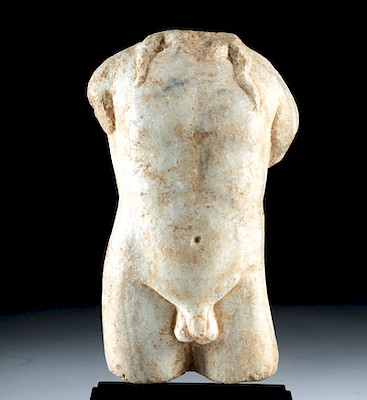Fantastic Egyptian Polychrome Canopic Jar Lid - TL'd
Lot 14
About Seller
Artemis Gallery
686 S Taylor Ave, Ste 106
Louisville, CO 80027
United States
Selling antiquities, ancient and ethnographic art online since 1993, Artemis Gallery specializes in Classical Antiquities (Egyptian, Greek, Roman, Near Eastern), Asian, Pre-Columbian, African / Tribal / Oceanographic art. Our extensive inventory includes pottery, stone, metal, wood, glass and textil...Read more
Estimate:
$3,000 - $4,000
Absentee vs Live bid
Two ways to bid:
- Leave a max absentee bid and the platform will bid on your behalf up to your maximum bid during the live auction.
- Bid live during the auction and your bids will be submitted real-time to the auctioneer.
Bid Increments
| Price | Bid Increment |
|---|---|
| $0 | $25 |
| $300 | $50 |
| $1,000 | $100 |
| $2,000 | $250 |
| $5,000 | $500 |
| $10,000 | $1,000 |
| $20,000 | $2,500 |
| $50,000 | $5,000 |
| $100,000 | $10,000 |
| $200,000 | $20,000 |
About Auction
By Artemis Gallery
Dec 5, 2018
Set Reminder
2018-12-05 10:00:00
2018-12-05 10:00:00
America/New_York
Bidsquare
Bidsquare : DAY 1 | Classical Antiquities & Asian Art
https://www.bidsquare.com/auctions/artemis-gallery/day-1-classical-antiquities-asian-art-3698
Day 1 of an important 2-day auction featuring ancient and ethnographic art from around the world. Egyptian, Greek, Roman, Viking, Near Eastern plus Asian Art from China, Japan, Thailand, Vietnam, Burma, India, more. Artemis Gallery info@artemisgallery.com
Day 1 of an important 2-day auction featuring ancient and ethnographic art from around the world. Egyptian, Greek, Roman, Viking, Near Eastern plus Asian Art from China, Japan, Thailand, Vietnam, Burma, India, more. Artemis Gallery info@artemisgallery.com
- Lot Description
Egypt, New Kingdom, 18th Dynasty, ca. 1479 to 1401 BCE. A fantastic example of a ceramic canopic jar lid, with the face of the god Imsety molded and painted onto the side of the lid. Much of the jar is taken up by a bright blue glaze that creates the flowing wig of the god; his face occupies a small part of the side, with a raised nose and lips and deepset eyes. Black paint gives the idea of kohl around the eyes. The interior of the jar lid is painted bright white, as is the very lower part of the rim. Size: 6.35" W x 3.2" H (16.1 cm x 8.1 cm)
Canopic jars are some of the most iconic artifacts from Egypt, made to hold internal organs removed during the mummification process. This tradition lasted for an incredibly long time - the first evidence for a canopic chest containing organs comes from the Fourth Dynasty (ca. 2600 BCE) and they were used into the late 1st millennium BCE. The 18th Dynasty marked a shift in canopic jar tradition, when these jars were given to all people of status, and when their heads were fashioned to look like the four Sons of Horus, including Imsety. The Four Sons were charged with protecting the internal organs, as they had originally been charged with protecting the body of Osiris. Imsety protected the liver and had a special relationship with the goddess Isis.
This piece has been tested using thermoluminescence (TL) and has been found to be ancient and of the period stated. A full report will accompany purchase.
Provenance: private Pasadena, California, USA collection
All items legal to buy/sell under U.S. Statute covering cultural patrimony Code 2600, CHAPTER 14, and are guaranteed to be as described or your money back.
A Certificate of Authenticity will accompany all winning bids.
We ship worldwide and handle all shipping in-house for your convenience.
#128405Losses from edges of rim, otherwise in good condition, with nice remaining pigment and details. Two small drilled holes for TL test.Condition
- Shipping Info
-
All shipping is handled in-house for your convenience. Your invoice from Artemis Gallery will include shipping calculation instructions. If in doubt, please inquire BEFORE bidding for estimated shipping costs for individual items.
-
- Buyer's Premium



 EUR
EUR CAD
CAD AUD
AUD GBP
GBP MXN
MXN HKD
HKD CNY
CNY MYR
MYR SEK
SEK SGD
SGD CHF
CHF THB
THB

















